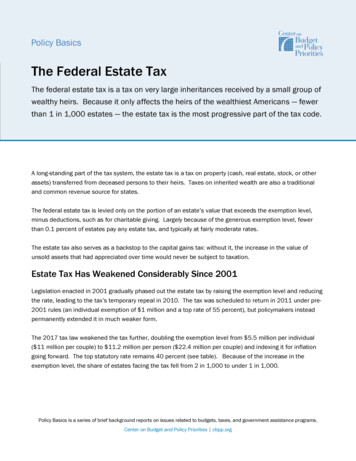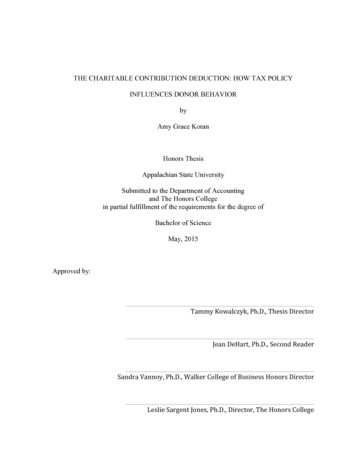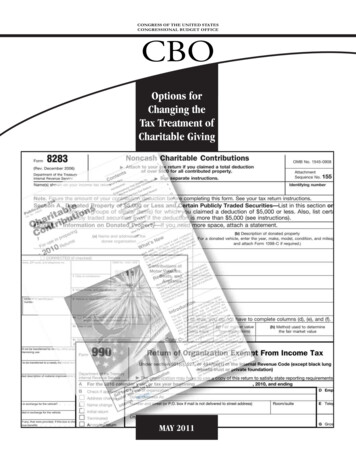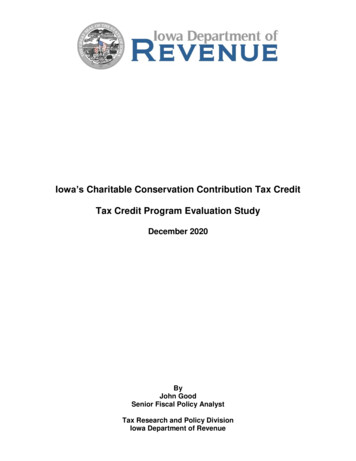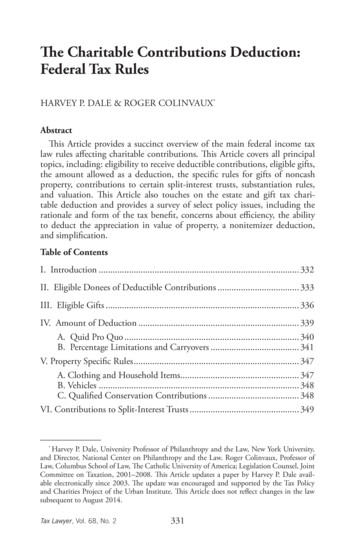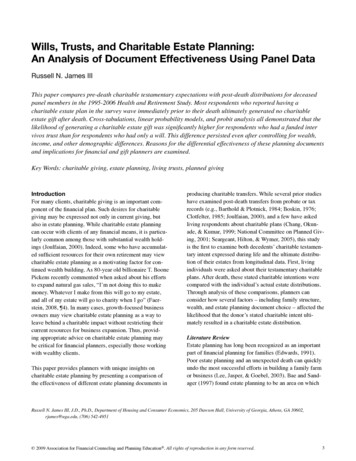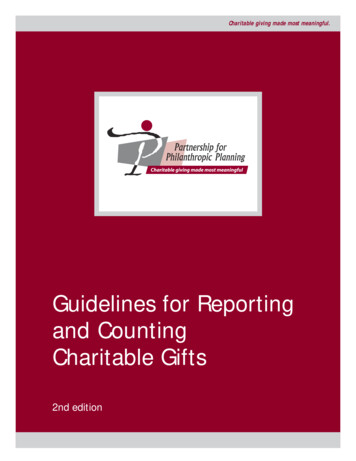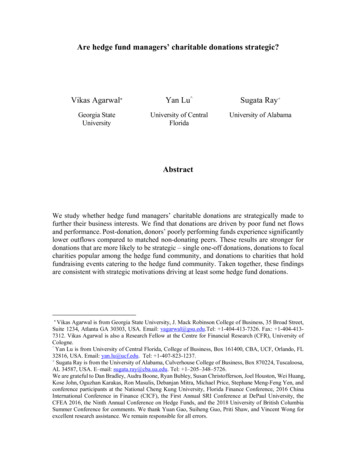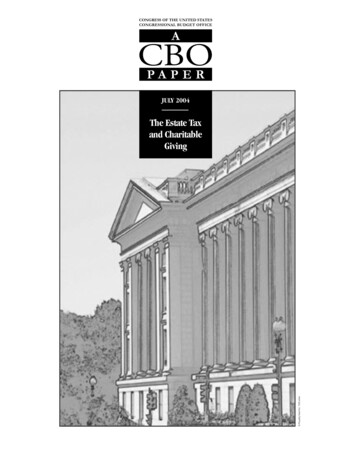
Transcription
CONGRESS OF THE UNITED STATESCONGRESSIONAL BUDGET OFFICEACBOPAPERJULY 2004 Royalty-free/Vol. 70/CorbisThe Estate Taxand CharitableGiving
ACBOPA P ERThe Estate Tax and Charitable GivingJuly 2004The Congress of the United States O Congressional Budget Office
PrefaceThis paper by the Congressional Budget Office (CBO), prepared at the request of theRanking Member of the Senate Finance Committee, examines the effect that changing theestate tax would have on donations to charity. Because charitable bequests lower the taxableamount of estates, the tax gives people an incentive to contribute to charity at death ratherthan leave assets to heirs. Furthermore, the estate tax provides an incentive to make charitablecontributions during life. The paper finds that increasing the amount exempted from theestate tax from 675,000 to either 2 million or 3.5 million would reduce charitable givingby less than 3 percent. However, repealing the tax would have a larger impact, decreasingdonations to charity by 6 percent to 12 percent.Robert McClelland and Pamela Greene of CBO’s Tax Analysis Division wrote the paperunder the direction of Roberton Williams and G. Thomas Woodward. Kurt Seibert andBenjamin Vallis provided research assistance, and Julie Somers, David Weiner, and ArleneHolen provided useful comments. In keeping with CBO’s mandate to provide objective analysis, the paper makes no recommendations.John Skeen edited the manuscript, and Christian Spoor proofread it. Denise Williams prepared early drafts of the text, the tables, and the figure. Maureen Costantino designed thecover and prepared the report for publication. Lenny Skutnik produced the printed copies,and Annette Kalicki prepared the electronic versions for CBO’s Web site (www.cbo.gov).Douglas Holtz-EakinDirectorJuly 2004
CONTENTSSummary 1Characteristics of Contributors 1Incentives for Charitable Giving 3Effects of Raising the Exemption Level and of Repealing theEstate Tax 4Appendix A: How CBO Estimated Changes in CharitableContributions 9
viTHE ESTATE TAX AND CHARITABLE GIVINGTables1.2.3.4.Schedule of Tax Rates and Estate Tax Exemptions UnderPre-2001 Law and Current Law5Estimated Effects on Charitable Contributions in 2000 fromChanges in the Estate Tax, Under Different Scenariosfor the Growth of Assets6Estimated Changes in Individual Income Tax Revenuesin 2000 from Changes in the Estate Tax, UnderDifferent Scenarios for the Growth of Assets8Estimated Effects on Charitable Bequests in 2000 fromChanges in the Estate Tax8Estimated Changes in Charitable Contributions in 2000 fromChanges in the Estate Tax7Families’ Wealth and Their Contributions to Charity2Figure1.Box1.
The Estate Tax and Charitable GivingSummaryUnder current law, the federal estate tax will diminishthrough 2009 as rates fall and the amount of wealth exempt from the tax increases. The tax then disappears entirely in 2010 but returns the following year to levels setby 1997 law. Those changes will affect not only estate taxrevenues but also donations to charity. A person with ataxable estate who makes charitable donations, eitherduring life or at death, reduces the size of his or her estateand thus lowers the estate tax liability. As a result, the person faces a lower effective cost of giving, which providesan additional incentive to make those gifts. Thus, although the principal role of the estate tax is to raise revenues, its impact on donations may be a policy consideration.Reducing the estate tax by exempting more wealth fromthe tax has two separate, opposite effects. By raising aftertax wealth, the lower tax may induce some people to givemore to charity. At the same time, those individualsnewly exempt from the estate tax have less incentive togive and may reduce their giving. This report examinespotential reductions in charitable giving during life (charitable contributions) and at death (charitable bequests)that would result from three changes to the estate tax: increasing the amount of wealth exempt from estate taxation to 2 million or 3.5 million or repealing the tax.(Those changes are due to take effect in stages under current law but then are due to lapse.) To allow for possiblevariation in how people expect their wealth to changeover time, the analysis of each change considers four scenarios that assume different rates of growth of assets during owners’ lives. The analysis does not consider changesin either estate tax rates or the credit against the estate taxfor state death taxes.The analysis finds that permanently raising the amountof wealth exempt from the estate tax to either 2 millionor 3.5 million would reduce charitable giving by lessthan 3 percent, as increased giving by the wealthiest donors would partly offset lower giving by donors withwealth below those cutoffs. However, permanently repealing the estate tax would cause a larger decline in charitable giving—of 6 percent to 12 percent. For the federalgovernment, reduced giving would directly raise incometax revenues by lowering the amounts claimed as itemizeddeductions for charitable contributions. That revenuegain would partially offset the loss in revenue caused byrepealing the estate tax.Characteristics of ContributorsAccording to the American Association of FundraisingCounsel’s (AAFRC’s) Trust for Philanthropy, charities received an estimated 201 billion in 2003. Nearly 90 percent of such giving occurs during donors’ lives; those giftsare termed charitable contributions. The balance of thosegifts, made from donors’ estates, are charitable bequests.1Using the most recent suitable data on individuals’ giving(as opposed to information on nonprofit organizations’receipts), this report examines charitable giving in 2000.By the Congressional Budget Office’s (CBO’s) estimation, individuals contributed 196 billion to charity1. See Center on Philanthropy at Indiana University, Giving USA2004: The Annual Report on Philanthropy for the Year 2003 (Indianapolis, Ind.: AAFRC Trust for Philanthropy, 2004). The amountcited is not the total amount reported to the Internal Revenue Service (IRS). Total charitable giving may differ from that reportedon tax returns for several reasons. Only a portion of charitablecontributions is report to the IRS—that given by people whoitemize their deductions on their tax returns. (The amounts thatpeople reported may overstate their actual contributions, however.) Similarly, only a portion of charitable bequests is reported—that willed by decedents with estates exceeding the filing thresholdfor the estate tax.
2THE ESTATE TAX AND CHARITABLE GIVINGBox 1.Families’ Wealth and Their Contributions to CharityAccording to the Congressional Budget Office’s analysis of the Survey of Consumer Finances, about 40percent of the people surveyed contributed at least 500 to charity in 2000. Families giving at least thatmuch donated an average of 4,400. Not surprisingly, wealthier families were both more likely tocontribute and contributed more (see the table).About a third of families with less than 500,000 inNet WorthLess than 0.5 Million 0.5 Million to 1 Million 1 Million to 3 Million 3 Million to 5 Million 5 Million to 50 Million 50 Million or Moreassets contributed 500 or more. But about threequarters of families worth between 500,000 and 1million contributed at that level, and more than 90percent of families with more than 3 million in assets did so. Average contributions also climbed from 2,300 for families with less than 500,000 in assetsto almost 400,000 for those with 50 million ormore.Millions ofFamiliesPercentage of FamiliesGiving at Least 500Average Contribution fromFamilies Giving at Least 50090.798.265.210.931.280.02327382909595 2,300 3,000 5,900 19,200 37,500 391,400Source: Congressional Budget Office based on Board of Governors of the Federal Reserve System, Survey of Consumer Finances(prepared by National Opinion Research Center, University of Chicago, 2001).that year, and about 16 billion in charitable bequestswas deducted on estate tax returns.2 (See the appendix foran explanation of CBO’s estimation of charitable contributions.)According to the CBO’s analysis of the 2001 Survey ofConsumer Finances (sponsored by the Board of Governors of the Federal Reserve System), which records income and contributions in 2000, more than 60 percentof contributions in 2000 came from families whose adjusted gross income was in the top quintile (the top 20percent). Families with adjusted gross income in the top10 percent made about half of all contributions, andthose in the top 5 percent gave about 45 percent of allcontributions.In general, as might be expected, wealthier families aremore likely to contribute than less wealthy families, and2. Why that estimate of total contributions is larger than theupdated figure of 175 billion estimated for that year in GivingUSA 2004 is unclear.their average contributions are larger (see Box 1). Familieswith a net worth greater than 675,000 (the amount exempted from the estate tax in 2000) made about twothirds of the total contributions.3 Families with assetsgreater than 3.5 million made about 45 percent of contributions; and families with assets greater than 7 million, about one-third. Families with assets greater than 20 million made about one-sixth of all contributions.In 2000, about one-sixth of decedents’ estates filing estatetax returns left a charitable bequest. Altogether, those bequests totaled 16 billion. Charitable bequests were evenmore heavily concentrated at the top of the wealth distribution than charitable contributions: over 70 percent ofreported charitable bequests were left by decedents withestates larger than 3.5 million; more than 60 percent3. Net worth should not be confused with the taxable estate. Whencalculating the taxable estate, net worth may be reduced by suchthings as charitable bequests, discounts for owning minorityshares of assets, bequests to a surviving spouse, funeral expenses,and an executor’s commission.
THE ESTATE TAX AND CHARITABLE GIVINGwere left by decedents with estates larger than 7 million;and more than 40 percent, estates in excess of 20 million.Single and widowed individuals are more likely to makecharitable bequests and to leave larger charitable bequeststhan married individuals are. In 2000, 40 percent of estate tax returns that were filed on behalf of single individuals included charitable bequests, and 23 percent of returns filed for widows or widowers did—compared withonly 6 percent of returns filed for married individuals.Charitable bequests left by single and widowed individuals are larger as well; for single decedents, bequests accounted for 37 percent of the estate and for widows andwidowers, 21 percent—but for married decedents, only 7percent. Those patterns presumably arise because marriedpeople can take advantage of the spousal exemption toavoid taxes on some wealth and are more concernedabout providing for spouses than providing for charitiesand because widowed people are more likely than singleindividuals to have children to whom they wish to leavemoney.Incentives for Charitable GivingPeople make charitable gifts for a variety of reasons. Overand above those reasons, the tax code may influence thelevel of giving by affecting both its “cost” (relative to thatof other possible uses for the money) and the amount ofresources available to individuals to give. Provisions in theindividual income tax and the estate tax affect both factors.Current income tax law allows most taxpayers who itemize their deductions to reduce their income subject to taxation by the amount of their charitable contributions. Asa result, the roughly 30 percent of taxpayers who itemizedo not pay income tax on allowable amounts contributedto charity. Those deductions reduce the cost of giving: ataxpayer in the 25 percent bracket who donates a dollarsees his or her tax bill drop by 25 cents, thus cutting theafter-tax cost of the donation to 75 cents. Lowering taxrates effectively increases that cost. For example, if therate was cut from 25 percent to 20 percent, the after-taxcost of donating a dollar would rise from 75 cents to 80cents. In essence, lowering tax rates increases the price ofdonations, reducing the incentive to donate.In a similar manner, charitable bequests are exempt fromthe estate tax, which effectively reduces their after-taxcost. A charitable bequest of a dollar from an estate facinga 45 percent estate tax yields a 45-cent reduction in theestate’s tax bill and thus cuts bequests to other beneficiaries by only 55 cents. The reduction effectively lowers thecost of the charitable bequest in terms of what heirs receive. Again, cutting estate tax rates raises that cost: reducing the rate from 45 percent to 32 percent would increase the cost of donating a dollar from 55 cents to 68cents.Besides affecting the relative cost of giving, both the income and estate taxes affect how much taxpayers have togive. The lower the level of taxes, the more after-tax income or wealth there will be available to give to charity.Therefore, repealing the estate tax could, in principle, induce people to leave more to charity than does the impetus currently provided by the estate tax.Increasing the exemption level has an effect similar to reducing tax rates for some, but not all, estates. Raising theexemption level increases the after-tax wealth for everyone facing the estate tax, and some of that additionalwealth may go to charity. However, for those people withestates previously subject to the estate tax but now exempt, the tax rate falls to zero, which raises the cost ofcharitable bequests to 100 percent of the amounts willed.Consequently, those people’s charitable bequests may, inprinciple, rise or fall, depending on which effect is stronger. Taxpayers with taxable wealth above the new exemption level face the same tax rate as before but have a lowerestate tax liability. Those taxpayers still have a tax incentive to make charitable bequests. Because they have moremoney available to give away, they will probably leavemore to charity. The total effect of raising the exemptiondepends on the relative strength of a declining incentiveto give and of increasing wealth.The estate tax also provides an incentive to contribute tocharity during life. Such contributions have the same effect as charitable bequests in reducing the assets subject tothe estate tax and also may be itemized deductions underthe income tax. Changes in the estate tax should affectcharitable contributions the same way as they affect charitable bequests. If an increase in the exemption level eliminates the expected estate tax burden for a family, the estate tax no longer provides an incentive to makecontributions during life, so those contributions may fall.If the higher exemption does not eliminate the estate taxburden, then the tax incentive to contribute remains andmore assets are available to be donated—and charitable3
4THE ESTATE TAX AND CHARITABLE GIVINGcontributions should rise. Whether aggregate charitablecontributions rise or fall depends on which effect dominates.Empirical analyses find, as expected, that repealing the estate tax would cause charitable giving to decline. Oneprominent analysis concludes, for example, that repealingthe tax would cause charitable bequests to fall by about12 percent.4 Other analyses suggest that charitable bequests could fall much more than that: one concludesthat charitable bequests would decline almost 40 percent,and another analysis estimates a 22 percent drop.5 Thepotential decrease in charitable bequests has been cited bycharitable groups such as the National Council of Nonprofit Associations and Independent Sector in their opposition to repealing the estate tax.6However, one observer has pointed out potential gainsthat the federal government would realize from a significant decline in charitable giving.7 First, taxpayers who reduce their charitable contributions would claim feweritemized deductions on their income tax returns, thusraising revenues. Second, because assets would be retained by donors and not moved into the untaxed charitysector, the income earned on those assets would remainsubject to income tax, further increasing revenues. Thoseeffects could partially offset the revenue loss from the repeal of the estate tax.4. David Joulfaian, “Estate Taxes and Charitable Bequests by theWealthy,” National Tax Journal, vol 53, no. 3 (September 2000),pp. 743-764.5. Jon M. Bakija and William G. Gale, “Effects of Estate Tax Reformon Charitable Giving,” Tax Policy Issues and Options, UrbanBrookings Tax Policy Center, no. 6 (July 2003), available atwww.urban.org/UploadedPDF/310810 TaxPolicy 6.pdf; andRobert McClelland, Charitable Bequests and the Repeal of the EstateTax, Technical Paper 2004-08 (July 2004), available atwww.cbo.gov/Tech.cfm.6. National Council of Nonprofit Associations, “Position Statement:Estate Tax,.” July 26, 2000, available at www.ncna.org/index.cfm?pageID 299; and Independent Sector, “Policy Positionon the Estate Tax and Charitable Tax Bequests” (March 2001),available at on.html.7. Martin Feldstein, “Kill the Death Tax Now,” Wall Street Journal,July 14, 2001; and “Estate Tax Repeal Makes Sense,” BostonGlobe, February 27, 2001.Few studies have examined the effect of the estate tax oncharitable contributions, and estimates are highly uncertain. Although derived from careful econometric analysisof tax data, past estimates have been based on donors’ behavior shortly before death, but donors expecting to diesoon would probably be more sensitive than others to theestate tax.8 Because donors make most contributions tocharity well before death, imputing the behavior of thosenear death to the whole population may overstate thesensitivity of contributions to changes in the estate tax. Arecent analysis examining donors age 50 or older finds aweaker effect of the estate tax on charitable contributions.9Effects of Raising the Exemption Leveland of Repealing the Estate TaxThe Economic Growth and Tax Relief Reconciliation Actof 2001 (EGTRRA) established the amounts effectivelyexempted from the estate tax at 1 million ( 2 million formarried couples) in 2002, 2 million ( 4 million formarried couples) in 2006, and 3.5 million ( 7 millionfor married couples) in 2009. It also decreased the top taxrate gradually from 55 percent to 45 percent in 2009.10In 2010, the estate tax is eliminated. After that year, thelaw reverts to the pre-EGTRRA tax structure, with a 1million exemption ( 2 million for married couples)(see Table 1).Because EGTRRA phases in gradually, opponents of repealing the estate tax have proposed to freeze the reductions at some point before 2010, while proponents haveproposed making the repeal permanent. That situationsuggests three potential scenarios for evaluation: immedi8. Gerald Auten and David Joulfaian, “Charitable Contributionsand Intergenerational Transfers,” Journal of Public Economics, vol.59, no. 1 (1996), pp. 55-68.9. Pamela Greene and Robert McClelland, The Effects of FederalEstate Tax Policy on Charitable Contributions, Technical Paper2001-2 (March 2001), available at www.cbo.gov/Tech.cfm.10. Estate and gift tax law provides an unlimited spousal exemption.With minimally competent estate planning, a married couple cantake advantage of that provision and a “bypass trust” to double theamount of wealth exempt from taxation. Prior to EGTRRA, theestate tax and the gift tax were part of a unified tax. Because thedifference between the two created in EGTRRA does not affectthe current analysis, only the estate tax is explicitly mentioned. Asurtax of 5 percent is applied to estates between 10 million and 17.184 million.
THE ESTATE TAX AND CHARITABLE GIVINGTable 1.Schedule of Tax Rates and Estate Tax Exemptions Under Pre-2001 Lawand Current LawPre-2001 Law (TRA 97)Top RateAmount t Law (EGTRRA)Top RateAmount 00Source: Joint Committee on Taxation.Notes: TRA97 Taxpayer Relief Act of 1997; EGTRRA Economic Growth and Tax Relief Reconciliation Act of 2001; n.a. not applicable.Rates shown under pre-2001 law and for 2001 under EGTRRA do not include the 5 percent surtax on estates between 10 million and 17.184 million.ately and permanently setting the exemption level at 2million ( 4 million for married couples); immediatelyand permanently setting the exemption level at 3.5 million ( 7 million for married couples); and immediatelyand permanently repealing the estate tax.For each of those cases, CBO evaluated only the simulated change in the exemption level and did not take intoaccount EGTRRA’s provisions reducing estate tax rates orthat law’s change in the treatment of state death taxes(shifting from a credit to a deduction). Limitations ofavailable data preclude estimating the parameters neededto simulate the effect of rate changes. Moreover, the likelychanges in state tax law in response to the change in thetreatment of state death taxes add uncertainty to estimating the effective change in the federal tax rates. However,if the marginal tax rates for combined federal and state estate taxes were to fall, the declines in charitable contributions and bequests would be larger than those describedin this report.CBO’s analysis simulates the response of charitable contributions by households in 2000 to each change in theestate tax. The estimates presented answer the followingquestion: in 2000, how would households have changedtheir charitable contributions in response to an increasein the exemption level? For example, if an individual in2000 believed that the exemption level at the time of hisor her death would be 3.5 million instead of the scheduled level, how would his or her charitable contributionshave changed?Because a person’s expected estate depends on how he orshe anticipates assets to grow over time and that expectation is unknown to analysts, CBO simulated changes incharitable contributions under several scenarios for thegrowth of assets. That procedure provides a range of estimates that may bracket the actual outcome.The four scenarios for the growth of assets assume fixedassets and low, medium, and high growth rates (see theappendix for details). The fixed-asset scenario assumesthat people believe they will have the same wealth whenthey die as in the year they reported their wealth. Thelow-, medium-, and high-growth scenarios assume realannual growth rates of 2 percent, 3 percent, and 4 per-5
6THE ESTATE TAX AND CHARITABLE GIVINGTable 2.Estimated Effects on Charitable Contributions in 2000 from Changes in theEstate Tax, Under Different Scenarios for the Growth of Assets(Percentage change)Alternative Tax Law 2 Million Exemption 3.5 Million ExemptionRepeal of the Estate TaxRepeal of the Estate Taxwith Large Estates UnaffectedaFixed AssetsLow GrowthMedium GrowthHigh Growth0-1-7-1-1-110-1-70-1-6-1-30-1Source: Congressional Budget Office.Note: Under the fixed-asset scenario, people believe they will have the same wealth at death as in 2001. The low-, medium-, and highgrowth scenarios assume real annual growth rates of 2 percent, 3 percent, and 4 percent, respectively. See the appendix for details.a. Estates in excess of 10 million are assumed to be insensitive to the incentive effect of the estate tax rate.cent, respectively, combined with typical patterns of saving and spending over the course of a life.11 It is possiblethat very wealthy people plan to leave fixed amounts totheir heirs and to give away the remainder of their estates.Such people would be unaffected by the tax incentive tocontribute to charity. To allow for that possibility, an alternative set of estimates assumes that those people withwealth greater than 10 million are entirely unaffected bythe tax incentive to contribute. In applying the scenarios,CBO estimated only the responses of people who were 50years old or older in 2000—and therefore more likely totake account of the estate tax.12Permanently raising the effective estate tax exemption to 2 million ( 4 million for married couples) would havecaused charitable contributions in 2000 to decline by nomore than 1 percent (see Table 2). Permanently raisingthe exemption to 3.5 million ( 7 million for marriedcouples) would have caused a similar decline.11. Those scenarios, described in more detail in Greene and McClelland, The Effects of Federal Estate Tax Policy on Charitable Contributions, were created in John J. Havens and Paul G. Schervish,“Millionaires and the Millennium: New Estimates of the Forthcoming Wealth Transfer and the Prospects for a Golden Age ofPhilanthropy” (Social Welfare Research Institute, Boston College,October 1999), available at df.12. If people’s giving is not influenced by the estate tax until they aremuch older than 50, the estimates in Tables 2 and 3 may be upperbounds.The small change in charitable contributions occurs fortwo reasons. First, although raising the exemption levelreduces the tax incentive to contribute, the predicted effect is small. Second, the drop in contributions is partiallyoffset by increased contributions from wealthier households, who would have more disposable after-tax wealthand an unchanged tax incentive to give.For example, under the fixed-asset scenario, increasingthe exemption to 3.5 million would have caused contributions to decrease by about 2 billion, or about 1 percent. Aggregate contributions from families with less than 7 million in assets would have decreased by slightlymore than 3 billion, but aggregate contributions fromwealthier families would have increased by 1 billion (seeFigure 1).Repealing the estate tax would cause a much larger decline in charitable contributions. If people with estateslarger than 10 million responded to the tax incentive,eliminating the tax would have caused charitable contributions to decline by 6 percent to 11 percent in 2000.Repealing the estate tax raises the cost of giving for allhouseholds that would have owed estate taxes, so the balancing of losses from one set of households with gainsfrom another does not occur. Under the alternative assumption that people with estates above 10 million donot respond to the tax incentive, contributions would stillhave declined by up to 3 percent.The decrease in charitable contributions would also increase individual income tax revenues, partially offsetting
THE ESTATE TAX AND CHARITABLE GIVINGFigure 1.Estimated Changes in Charitable Contributions in 2000 from Changesin the Estate Tax(Billions of dollars)2Exemption Increased to 3.5 Million1Estate Tax Repealed0-1-2-3-4-50 to 0.675 0.675 to 3.5 3.5 to 7.0 7.0 to 20.0More than 20.0Assets in an Estate (Millions of dollars)Source: Congressional Budget Office.Note: The results presented in this figure are based on a simulation in which assets are fixed; that is, people believe they will have the samewealth the year they die as in the year they reported their wealth.the revenues lost from repealing the estate tax (see Table3). Unlike changes in the exemption, repealing the estatetax could increase individual income tax revenues by upto 6 billion, nearly a quarter of the 25 billion collectedin estate taxes in 2000. Even if people with assets worthmore than 10 million are insensitive to changes in theincentive, the offset could exceed 1.5 billion.Those increases are relatively large because most contributions are made by taxpayers who itemize their deductions and are wealthy. Further, those taxpayers tend to bein the top tax bracket, so a decrease in contributionssharply increases income tax revenues. Finally, itemizedcontributions ( 140 billion in 2000) are much largerthan estate tax revenues ( 25 billion in 2000), so evensmall percentage changes in itemized contributions arelarge relative to estate tax collections.The effect that changes in the exemption has on charitable bequests follows a pattern similar to that for charitable contributions, although the declines are much greater.An exemption of 2 million or 3.5 million would haveled to an 8 percent to 15 percent decline in charitable bequests in 2000 (see Table 4).13 Although the percentagedecreases are much larger than for charitable contributions, the total declines would have been even greaterwithout the increased bequests from larger estates.13. The ranges presented represent an estimate plus or minus a 3 percent margin of error, defined here as a 95 percent confidenceinterval. Estimates of the change in charitable bequests fromrepealing the estate tax come from McClelland, CharitableBequests and the Repeal of the Estate Tax. That analysis uses the estimated responses to changes in estate tax rates and wealth to simulate the effect that repealing the estate tax would have had on eachestate leaving a charitable bequest in 2000. Estimates of the effectof increases in the exemption follow a similar method.7
8THE ESTATE TAX AND CHARITABLE GIVINGTable 3.Estimated Changes in Individual Income Tax Revenues in 2000 from Changes inthe Estate Tax, Under Different Scenarios for the Growth of Assets(Billions of dollars)Alternative Tax Law 2 Million Exemption 3.5 Million ExemptionRepeal of the Estate TaxRepeal of the Estate Taxwith Large Estates UnaffectedaFixed AssetsLow GrowthMedium GrowthHigh 2Source: Congressional Budget Office.Note: Under the fixed-asset scenario, people believe they will have the same wealth at death as in 2001. The low-, medium-, and highgrowth scenarios assume real annual growth rates of 2 perc
tax returns left a charitable bequest. Altogether, those be-quests totaled 16 billion. Charitable bequests were even more heavily concentrated at the top of the wealth distri-bution than charitable contributions: over 70 percent of reported charitable bequests were left by decedents with estates larger than 3.5 million; more than 60 percent .


